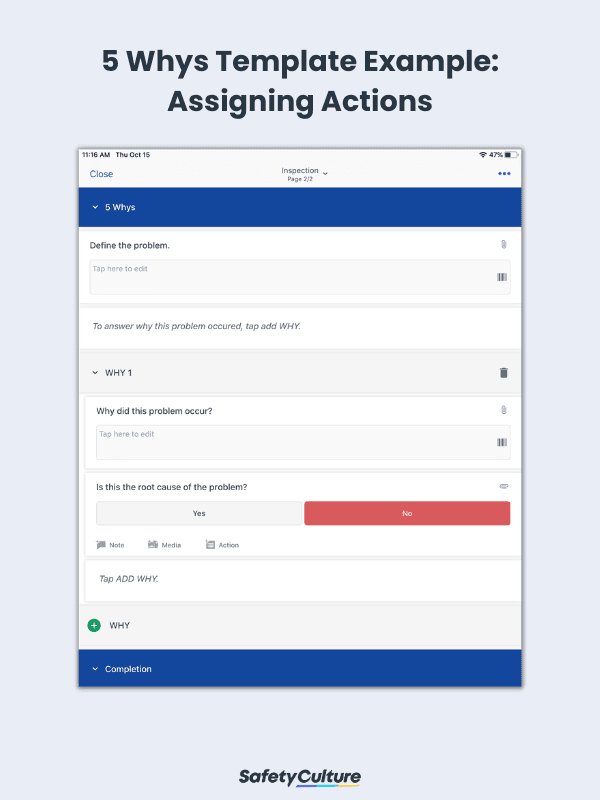What is a 5 Whys Template?
A 5 whys template is a powerful tool used for identifying the root cause of a problem following the 5 whys technique. Teams perform 5 whys root cause analysis using a 5 whys template by stating the problem and asking “why” five times until the root cause is discovered. Solutions are then formulated to prevent the problem from reoccurring.
What is the 5 Whys?
The 5 Whys is a problem-solving technique developed by the founder of Toyota Industries Corporation, Sakichi Toyoda. It is used by the company to detect manufacturing flaws and improve the quality of their products and processes. Using a 5 whys template can help in monitoring the effectiveness of countermeasures applied to previous problems.
What are the 5 Whys Questions?
Simply put, the 5 whys questions are literal questions of “Why?” asked 5 times until the root cause of an issue is finally realized. Here’s an example of 5 whys questions:
- Why are we unable to replace all the old vehicles like we planned for this year?
- Because we didn’t expect vehicle prices to go this high.
- Why are car prices so high?
- Because car dealers are low on inventory right now.
- Why are car dealers’ inventories low right now?
- There is a decrease in production by car manufacturers around the world.
- Why are car manufacturers experiencing low production right now?
- There is a global shortage of chips, also called microchips or semiconductors, a crucial component of vehicles and electronic devices.
- Why is there a shortage of chips for cars?
- As with almost all industries affected by the COVID-19 pandemic, chip manufacturers had to close their factories. By the time they resumed operations, there is such a great demand for mobile and electronic devices for people in their homes that manufacturers allocated chip production to address this demand.
What Should be Included in a 5 Whys Template?
To help drill down the root cause of a problem using the 5 Whys technique, it is practical to use a pre-existing template that could help document all the details involved in the endeavor. A 5 Whys template can include:
- The definition of the problem
- The reason why it occurred
- The confirmation if it’s the root cause
- The solution to the problem
- Completion (additional suggestions & signature of team manager)
5 Whys Analysis Example
In this 5 whys RCA example, you will see how the 5 whys questions are used to unravel an issue and come up with a solution to the problem.
- Problem: “There is a significant decline in the revenue of our company.” – Why?
“Most of our stores experience stock loss.” – Why?
“Data from inventory reports are overlooked.” – Why?
“The turnaround of reports is slow.” – Why?
“It is tedious to complete paperwork.” – Why? - Root Cause: Inventory audits using pen and paper are inefficient.
- Solution: Use a digital inspection app to streamline inventory audits and reporting.
How to Perform an Effective 5 Whys Analysis
Using the 5 whys as a root-cause analysis method may be simple, but it won’t be effective if participants overlook its baseline principles. Here are 3 ways team managers can best facilitate an effective 5 whys analysis, especially when implementing kaizen in the workplace:
Step #1: Have a clearly defined problem
Teams often struggle to determine the root cause because they fail to agree on the problem. Team managers should gather their teams and assist in establishing the problem based on current knowledge. It is crucial for 5 whys participants to refrain from blaming people and jumping to conclusions.
5 Whys Analysis Step #1 Example:
✖ Our finance department is incompetent.
✔ Problem: There is a significant decline in the revenue of our company.
Step #2: Know when to stop
5 whys participants should pay attention to the logic of the cause-and-effect relationship. Otherwise, they might keep on coming back to the problem or conclude before they arrive at the root cause. Team managers should train their teams on how to distinguish causes from symptoms. As a rule of thumb, teams should not go further when responses become illogical.
5 Whys Analysis Step #2 Example:
✔ The turnaround of reports is slow. – Why?
✔ It is tedious to complete paperwork. – Why?
✔ Root Cause: Inventory audits using pen and paper are inefficient. – Why?
✖ The inventory checklist contains numerous details. – Why?
✖ We order, store and display a lot of products. – Why?
✖ It is necessary for our business. – Why?
Step #3: Delegate responsibility to the team
Teams usually encounter the same problems when they neglect following through on the effectiveness of their solutions. To efficiently monitor the implementation of solutions, team managers should delegate responsibilities to their team members. When each member takes action, teams foster an atmosphere of trust and increase accountability.
5 Whys Analysis Step #3 Example:
Solution: Use a digital inspection app to streamline inventory audits and reporting.
✔ Team member 1: Look for digital inspection apps online.
✔ Team member 2: Invite process manager to the next meeting.
✔ Team member 3: Remind each team member for the next meeting.




